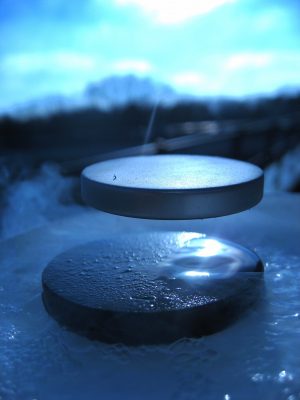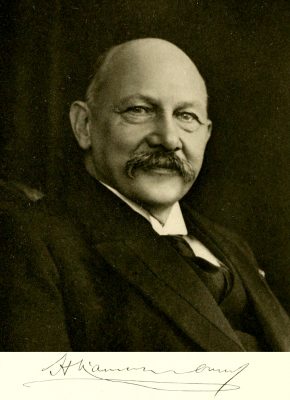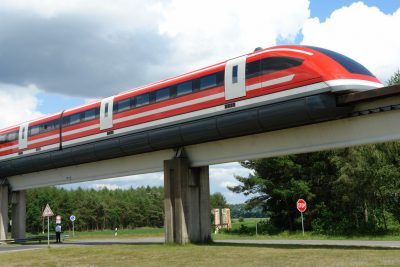Using superconductors
Superconductivity was discovered by Kamerlingh Onnes, a Dutch physicist in 1911. He discovered how to make liquid helium, that he used to cool various substances. He discovered that when you cool mercury to 4�K, that the electrical resistance goes down to zero. He received the Nobel Prize in 1913.
At higher temperature
We can only understand superconductivity using quantum mechanics, and even quantum mechanics has a major problems explaining all the phenomena about superconductivity. The problem started in 1986, when two scientists in Zurich, Muller and Bednorz, discovered that certain alloys can be made superconducting at a temperature as high as 35�K. Theorist earlier had proven that it was impossible to ever get superconductivity at that temperature. This was such as splash in the community, that they were awarded the Nobel Price within one year (1987).
As of today, theorists still cannot explain fully why there is what’s called high-temperature superconductivity. Today’s record is 135�K. Since liquid nitrogen has a temperature of 77�K, anyone can now play with superconducting materials, because liquid nitrogen is easy to come by.
If you have zero resistance in a material, you can run an extremely high current through it and therefore get magnetic fields as high as 6T. Such superconducting coils are used in the colliders that we talked about earlier.
No electric field can exist in a superconductor. If there were an electric field, there would be a potential difference over the superconductor. Ohm’s law tells you that if the potential difference is not zero, and the resistance is zero, then the current would go to infinity.�=�↑∞�=0
Levitating magnet
If we approach a superconducting disk with a magnet, there will be a change in magnetic flux. Based on Faraday’s law there will be an EMF generated in the disk.
However, that EMF must remain zero because the resistance � of the superconductor is zero. No matter what the current is, there cannot be an EMF�=�↑∞�=0
As the magnet approaches, eddy currents are going to flow inside the superconductor. These eddy currents create a magnetic field themselves. These eddy current make sure that the net change in magnetic flux ���/�� is always zero.�����=0
Since there was no magnetic flux when the magnet was high up, and the eddy current cancel out any change in magnetic flux. there will never be a net magnetic flux inside the superconductor.
Magnetic pressure
The sketch on the left shows, the magnetic field from the bar magnet and of the eddy currents in the superconductor. The top of the superconductor acts as a north pole, repelling the north pole of the magnet.
The sketch on the right shows, the superposition of the two fields. You get a squeezed field between the magnet and the superconductor. When you have such a squeezed magnetic field, there is magnetic pressure because the north poles repel each other. The magnetic pressure � can be expressed as(magnetic pressure)�=�22�0[Nm2]
The end result is that the magnet is repelled. Pushed up by the superconductor. Even when you start rotating the magnet, the eddy currents will instantaneously adjust to always repel the magnet.
 A superconductor levitating a permanent magnet
A superconductor levitating a permanent magnetJulien Bobroff &Frederic Bouquet / CC BY-SA 3.0 / supraconductivite.fr
The eddy current never dissipates any heat. There is no �2�, because � is zero. So you never lose the eddy current. The currents never die out! This is different with the next form of levitation.
Using velocity
Another for of levitation is where you move a magnet fast over a conducting surface.
As the magnet overs over the conducting plate, the magnetic flux through that plate will change. Lenz’s law says it will run an eddy currents so that its magnetic field opposes that of the magnet.
The north pole of the eddy current opposes the north pole of the magnet. If the magnet has an high enough speed, so that the change in magnetic flux ��/�� is high, the train can float. Many of tons of weight can be made to float.
For the train to float, it has to keep going. If the trains stops the eddy current will die out. There’s no longer a ��/��, but there is resistance in the conductor. So you get Ohmic dissipation �2�. The heat will dissipated in the conductor, and the train will just plunge down.
That was not the case with the superconductor, because superconductors don’t dissipate any heat. But the idea is the same, as you get a squeezed magnetic field that causes magnetic pressure.
Japan and Germany are leaders in the world of magnetic levitation trains. There is an enormous reduction in friction if you can have a train that is not in contact with the rails. Speeds have been recorded up to 550km/h. It is no more expensive as building a 4-lane highway at 30M$/mile.
Using alternating current
There is a third form of magnetic levitation whereby we don’t need any speed or superconductors. We feed alternating current (AC) to a solenoid placed over a conducting plate.
Say, at one moment in time the magnetic field is shown below and is increasing. Then of course the magnetic field turns around, up, down, up, down, because it’s AC. We have this continuous magnetic field change, so we have a continuous change in magnetic flux in that plate.
At the moment in time, that the �→-field is down and increasing, we’re going to get an eddy current which will create an opposing magnetic field. Again, you have two opposing north poles. So again, the eddy current in the conducting plate is responsible for a magnetic field and the two repel each other.
A little later in time, the magnetic field strength will decrease. When that happens the eddy current will reverse direction, and the two will attract each other. It now seems quite reasonable that half the time they will attract each other and the other half of the time they will repel each other. That however is not the case. There will be a net repelling force, that we will explain that in the next lecture.
AC Levitation – part 2
(Continuing “Levitation using AC current“”)
The behavior depends on the AC current’s sine wave
- Between the 0° and 90° of the current, the magnetic field points down and is increasing in strength. Because it is increasing in strength, the eddy currents will be in the opposite direction. The magnetic fields will repel each other. (As shown in the illustration above.)
- Between the 90° and 180° of the the current, the magnetic field of the inductor still points down, but is decreasing in strength. Because it is decreasing, ��/�� is negative and the EMF flips over. Now, the eddy currents are in the same direction as the current through the solenoid. The magnetic fields will attract.
One would expect that half the time the solenoid and the conductor attract, and half the time they repel. So the net effect would be no levitation. However, it is not that simple ..
The secret
As we will see in RL Circuit with AC current, the secret lies in the self-inductance. The eddy current runs over a path which has a resistance � and self-inductance �. So in the conductor we get an induced current that is delayed over the induced EMF, driven by equation (???).�=arctan���
The red curve is the current for the coil. When it is positive, it is clockwise, otherwise anti-clockwise. The green curve is the EMV which is induced in the conductor.
Notice when the magnetic field increases, the current goes up in the coil, then the EMF in the conductor is in such a direction that it opposes the change in that magnetic field.
Now when the magnetic field decreases, the current in the coil decreases, immediately the EMF flips over. Therefore if the induced current and the induced EMF were in phase with each other, half the time you would have attraction, and half the time you would have that the two repel each other.
When we add a blue curve representing the induced current,
If there is no phase shift between the induced EMF and the induced current, half the time the blue and red curve are in opposite direction.
Now, if I have a phase delay, so that the induced current comes later than the EMF, say 90°
Now, the red curve and the blue curve are always in opposite directions. Now all the time there is a repelling force.
Even if the phase delay is less than 90°, the net result is that on average you get a repelling force. So the secret of the repelling force, lies in the fact that there is a finite self-inductance in the conductor.
If � is zero, then of course we have a superconductor, then � is always 90°. The floating magnet above a super conductor, was such an ideal case.





























